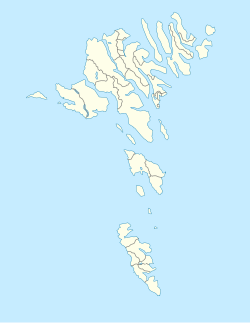Vestmanna | |
|---|---|
Municipality and village | |
 Vestmanna in 2002 | |
 Location of Vestmanna kommuna in the Faroe Islands | |
| Coordinates: 62°09′23″N7°09′59″W / 62.15639°N 7.16639°W | |
| State | |
| Constituent country | |
| Island | Streymoy |
| Population (September 2025) [1] | |
• Total | 1,260 |
| Time zone | GMT |
| • Summer (DST) | UTC+1 (WEST) |
| Postal code | FO 350 |
| Climate | Cfc |
| Website | https://vestmanna.fo/ |
Vestmanna is a town in the Faroe Islands on the west of the island of Streymoy.
Contents
- History
- Geography
- Tourism
- Photos from Vestmannabjørgini and Vestmanna
- See also
- References
- External links
It was formerly a ferry port, until an undersea tunnel, the Vágatunnilin, was built from Vágar to Kvívík and Stykkið further south on Streymoy. The cliffs west of Vestmanna, Vestmannabjørgini, are very popular for excursions by boat.
A 'Vestmann' was a "Westman", or Gael in Old Norse. The original name was Vestmannahavn, i.e. "Westmen's/Irishmen's harbour".








